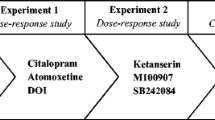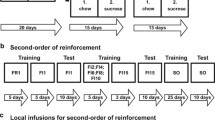Abstract
Rationale
Repeated administrations of the D2/D3 agonist quinpirole (QNP) to rats elicit an antieconomical pattern of drinking called “contrafreeloading” (CFL), a putative model of compulsive-like behavior.
Objectives
We tested the sensitivity of QNP-induced CFL to haloperidol (HAL), aripiprazole (ARI), and clomipramine (CIM), the latter proven effective in the treatment of obsessive–compulsive disorder (OCD).
Methods
Rats were trained under a schedule of reinforcement (FR3) for water. On days 1–6, water was only available through lever pressing. On days 7–15, a choice between operant and free access was provided. QNP 0.5 mg/kg was administered alone or in combination with HAL (0.1 or 0.2 mg/kg), ARI (0.3 or 1 mg/kg), or CIM (5 or 10 mg/kg).
Results
Acutely QNP suppressed operant behavior and, therefore, water intake; upon repeated administrations, tolerance developed to this suppressant effect on responding but only to a lesser extent to the antidipsic effect. In choice conditions, QNP induced a progressive preference for the operant access (CFL). HAL per se, but not CIM and ARI, significantly reduced both responding and drinking (operant phase). In the choice phase, HAL and CIM inhibited CFL, but only the latter reinstated total water intake. ARI, in combination with QNP, increased responding.
Conclusions
CIM reinstates control patterns of drinking, while HAL and ARI where partially or not effective at all, respectively. As far as CIM is considered a first line treatment in OCD, these results further strengthen the notion that QNP-induced CFL belongs to the realm of dopaminergic drug-induced compulsive behaviors.



Similar content being viewed by others
References
Amato D, Milella MS, Badiani A, Nencini P (2006) Compulsive-like effects of repeated administration of quinpirole on drinking behavior in rats. Behav Brain Res 172:1–13
Amato D, Milella MS, Badiani A, Nencini P (2007) Compulsive-like effects of quinpirole on drinking behavior in rats are inhibited by substituting ethanol for water. Behav Brain Res 177:340–346
Amato D, Stasi MA, Borsini F, Nencini P (2008) Haloperidol both prevents and reverses quinpirole-induced nonregulatory water intake, a putative animal model of psychogenic polydipsia. Psychopharmacology 200:157–165
American Psychiatric Association (2000) Diagnostic and statistical manual of mental disorders (4th edn., revised). Washington DC: Author
Bäckström P, Etelälahti TJ, Hyytiä P (2011) Attenuation of reinforcing and psychomotor stimulant effects of amphetamine by aripiprazole. Addict Biol 1:55–63
Boulougouris V, Castañe A, Robbins TW (2009) Dopamine D2/D3 receptor agonist quinpirole impairs spatial reversal learning in rats: investigation of D3 receptor involvement in persistent behaviour. Psychopharmacology 202:611–620
Bratcher NA, Farmer-Dougan V, Dougan JD, Heidenreich BA, Garris PA (2005) The role of dopamine in reinforcement: changes in reinforcement sensitivity induced by D1-type, D2-type, and nonselective dopamine receptor agonists. J Exp Anal Behav 3:371–399
Burris KD, Molski TF, Xu C, Ryan E, Tottori K, Kikuchi T, Yocca FD, Molinoff PB (2002) Aripiprazole, a novel antipsychotic, is a high-affinity partial agonist at human dopamine D2 receptors. J Pharmacol Exp Ther 302:381–389
Cavedini P, Riboldi G, D'Annucci A, Belotti P, Cisima M, Bellodi L (2002) Decision-making heterogeneity in obsessive-compulsive disorder: ventromedial prefrontal cortex function predicts different treatment outcomes. Neuropsychologia 40:205–211
Cioli I, Caricati A, Nencini P (2000) Quinpirole- and amphetamine-induced hyperdipsia: influence of fluid palatability and behavioral cost. Behav Brain Res 109:9–18
Dahan L, Husum H, Mnie-Filali O, Arnt J, Hertel P, Haddjeri N (2009) Effects of bifeprunox and aripiprazole on rat serotonin and dopamine neuronal activity and anxiolytic behavior. J Psychopharmacol 23:177–189
Dell'Osso B, Nestadt G, Allen A, Hollander E (2006) Serotonin-norepinephrine reuptake inhibitors in the treatment of obsessive–compulsive disorder: a critical review. J Clin Psychiatry 67:600–610
Denk F, Walton ME, Jennings KA, Sharp T, Rushworth MFS, Bannerman DM (2005) Differential involvement of serotonin and dopamine systems in cost–benefit decisions about delay or effort. Psychopharmacology 179:587–596
Eagle DM, Baunez C (2010) Is there an inhibitory-response-control system in the rat? Evidence from anatomical and pharmacological studies of behavioral inhibition. Neurosci Biobehav Rev 34:50–72
Egashira N, Okuno R, Matsushita M, Abe M, Mishima K, Iwasaki K, Nishimura R, Oishi R, Fujiwara M (2008) Aripiprazole inhibits marble-burying behavior via 5-hydroxytryptamine (5-HT)1A receptor-independent mechanisms. Eur J Pharmacol 592:103–108
Eilam D, Szechtman H (2005) Psychostimulant-induced behavior as an animal model of obsessive–compulsive disorder: an ethological approach to the form of compulsive rituals. CNS Spectr 10:191–202
Ersche KD, Roiser JP, Robbins TW, Sahakian BJ (2008) Chronic cocaine but not chronic amphetamine use is associated with perseverative responding in humans. Psychopharmacology 197:421–423
Etievant A, Betry C, Arnt J, Haddjeri N (2009) Bifeprunox and aripiprazole suppress in vivo VTA dopaminergic neuronal activity via D2 and not D3 dopamine autoreceptor activation. Neurosci Lett 460:82–86
Faure A, Leblanc-Veyrac P, El Massioui N (2010) Dopamine agonists increase perseverative instrumental responses but do not restore habit formation in a rat model of Parkinsonism. Neuroscience 168:477–486
Fellows LK, Farah MJ (2003) Ventromedial frontal cortex mediates affective shifting in humans: evidence from a reversal learning paradigm. Brain 126:1830–1837
Fernandez-Guasti A, Ulloa RE, Nicolini H (2003) Age differences in the sensitivity to clomipramine in an animal model of obsessive–compulsive disorder. Psychoparmacology 166(3):195–201
Goodman WK, Price LH, Delgado PL, Palumbo J, Krystal JH, Nagy LM, Rasmussen SA, Heninger GR, Charney DS (1990a) Specificity of serotonin reuptake inhibitors in the treatment of obsessive–compulsive disorder. Comparison of fluvoxamine and desipramine. Arch Gen Psychiatry 47:577–585
Goodman WK, McDougle CJ, Price LH, Riddle MA, Pauls DL, Leckman JF (1990b) Beyond the serotonin hypothesis: a role for dopamine in some forms of obsessive compulsive disorder? J Clin Psychiatry 51:S36–S43
Haluk DM, Floresco SB (2009) Ventral striatal dopamine modulation of different forms of behavioral flexibility. Neuropsychopharmacology 34:2041–2052
Hirose T, Uwahodo Y, Yamanada S, Miwa T, Kikuchi T, Kitawaga H, Burris KD, Altar AC, Nabeshima T (2004) Mechanism of action of aripiprazole predicts clinical efficacy and a favourable side-effect profile. J Psychopharmacol 18:375–383
Inglis IR, Ferguson NJK (1986) Starlings search for food rather than eat freely available, identical food. Anim Behav 34:614–617
Ishiwari K, Weber SM, Mingote S, Correa M, Salamone JD (2004) Accumbens dopamine and the regulation of effort in food-seeking behavior: modulation of work output by different ratio or force requirements. Behav Brain Res 151:83–91
Jensen ED (1963) Preference for bar pressing over “free-loading” as a function of unrewarded presses. J Exp Psychol 65:451–454
Jerlhag E (2008) The antipsychotic aripiprazole antagonizes the ethanol- and amphetamine-induced locomotor stimulation in mice. Alcohol 42:123–127
Joel D (2006) Current animal models of obsessive compulsive disorder: a critical review. Prog Neuropsychopharmacol Biol Psychiatry 30:374–388
Joel D, Avisar A (2001) Excessive lever pressing following post-training signal attenuation in rats: a possible animal model of obsessive compulsive disorder? Behav Brain Res 123:77–87
Kenakin T (2007) Functional selectivity through protean and biased agonism: who steers the ship? Mol Pharmacol 72:1393–1401
Kikuchi T, Tottori K, Uwahodo Y, Hirose T, Miwa T, Oshiro Y, Morita S (1995) 7-(4-[4-(2,3-Dichlorophenyl)-1-piperazinyl]butyloxy)-3,4-dihydro-2(1H)-quinolinone (OPC-14597), a new putative antipsychotic drug with both presynaptic dopamine autoreceptor agonistic activity and postsynaptic D2 receptor antagonistic activity. J Pharmacol Exp Ther 274:329–336
Koener B, Goursaud S, Van De Stadt M, Calas AG, Jeanjean AP, Maloteaux JM, Hermans E (2010) Pharmacological blockade of dopamine D(2) receptors by aripiprazole is not associated with striatal sensitization. Naunyn Schmiedebergs Arch Pharmacol 383:65–77
Kurylo DD (2004) Effects of quinpirole on operant conditioning: perseveration of behavioral components. Behav Brain Res 155:117–124
Leite JV, Guimaraes FS, Moreira FA (2008) Aripiprazole, an atypical antipsychotic, prevents the motor hyperactivity induced by psychostimulants in mice. Eur J Pharmacol 578:222–227
McGowan RTS, Robbins CT, Alldredge JR, Newberry RC (2010) Contrafreeloading in grizzly bears: implications for captive foraging enrichment. Zoo Biol 29:484–502
Micallef J, Blin O (2001) Neurobiology and clinical pharmacology of obsessive–compulsive disorder. Clin Neuropharmacol 24:191–207
Milella MS, Amato D, Badiani A, Nencini P (2008) The influence of cost manipulation on water contrafreeloading induced by repeated exposure to quinpirole in the rat. Psychopharmacology 197:379–390
Milella MS, Passarelli F, De Carolis L, Schepisi C, Nativio P, Scaccianoce S, Nencini P (2010) Opposite roles of dopamine and orexin in quinpirole-induced excessive drinking: a rat model of psychotic polydipsia. Psychopharmacology (Berl) 211:355–366
Millan MJ, Gobert A, Lejeune F, Newman-Tancredi A, Rivet JM, Auclair A, Peglion JL (2001) S33005, a novel ligand at both serotonin and norepinephrine transporters: I. Receptor binding, electrophysiological, and neurochemical profile in comparison with venlafaxine, reboxetine, citalopram, and clomipramine. J Pharmacol Exp Ther 298:565–580
Nordquist RE, Risterucci C, Moreau JL, von Kienlin M, Kunnecke B, Maco M, Freichel C, Riemer C, Spooren W (2008) Effects of Aripiprazole/OPC-14597 on motor activity, pharmacological models of psychosis, and brain activity in rats. Neuropharmacology 54:405–416
Remijnse PL, Nielen MMA, van Balkom AJLM, Cath DC, van Oppen P, Uylings HBM, Veltman DJ (2006) Reduced orbitofrontal–striatal activity on a reversal learning task in obsessive–compulsive disorder. Arch Gen Psychiatry 63:1225–1236
Rogers RD, Everitt BJ, Baldacchino A, Blackshaw AJ, Swainson R, Wynne K, Baker NB, Hunter J, Carthy T, Booker E, London M, Deakin JFW, Sahakian BJ, Robbins TW (1999) Dissociable deficits in the decision-making cognition of chronic amphetamine abusers, opiate abusers, patients with focal damage to prefrontal cortex, and tryptophan-depleted normal volunteers: evidence for monoaminergic mechanism. Neuropsychopharmacology 20:322–339
Rogers RD, Tunbridge EM, Bhagwagar Z, Drevets WC, Shakian BJ, Carter CS (2003) Tryptophan depletion alters the decision-making of healthy volunteers through altered processing of reward cues. Neuropsychopharmacology 28:153–162
Salamone JD, Correa M (2002) Motivational views of reinforcement: implications for understanding the behavioral functions of nucleus accumbens dopamine. Behav Brain Res 137:3–25
Salamone JD, Cousins MS, Bucher S (1994) Anhedonia or anergia? Effects of haloperidol and nucleus accumbens dopamine depletion on instrumental response selection in a T-maze cost/benefit procedure. Behav Brain Res 65:221–229
Salamone JD, Correa M, Mingote S, Weber S (2003) Accumbens dopamine and the regulation of effort in food-seeking behavior: implications for studies of natural motivation and psychiatry. J Pharmacol Exp Ther 305:1–8
Salamone JD, Correa M, Farrar A, Mingote SM (2007) Effort-related functions of nucleus accumbens dopamine and associated forebrain circuits. Psychopharmacology 191:461–482
Shapiro DA, Renock S, Arrington E, Chiodo LA, Liu L, Sibley DR, Roth BL, Mailman R (2003) Aripiprazole, a novel atypical antipsychotic drug with a unique and robust pharmacology. Neuropsychopharmacology 28:1400–1411
Strange PG (2008) Antipsychotic drug action: antagonism, inverse agonism or partial agonism. Trends Pharmacol Sci 29:314–321
Szechtman H, Woody E (2004) Obsessive–compulsive disorder as disturbance of security motivation. Psychol Rev 111:111–127
Szechtman H, Sulis W, Eilam D (1998) Quinpirole induces compulsive checking behavior in rats: a potential animal model of obsessive–compulsive disorder (OCD). Behav Neurosci 112:1475–1485
Author information
Authors and Affiliations
Corresponding author
Additional information
Lorenza De Carolis and Chiara Schepisi equally contributed to the study.
Electronic supplementary material
Below is the link to the electronic supplementary material.
Fig. S1
Effect of QNP 0.5 mg/kg alone or in combination with HAL 0.1 or 0.2 mg/kg (upper row), ARI 0.3 or 1 mg/kg (middle row) and CIM 5 or 10 mg/kg (lower row) on percentage of water consumed/water gained from the dipper through lever pressing in operant (left side) and in choice phase (right side). Data are expressed as mean±SEM of cumulative 6 and 9 days of treatment for operant and choice phase, respectively. Post-hoc Bonferroni test, *P < 0.05 vs. veh + veh and #P < 0.05 vs. veh + QNP (PDF 344 kb)
Rights and permissions
About this article
Cite this article
De Carolis, L., Schepisi, C., Milella, M.S. et al. Clomipramine, but not haloperidol or aripiprazole, inhibits quinpirole-induced water contrafreeloading, a putative animal model of compulsive behavior. Psychopharmacology 218, 749–759 (2011). https://doi.org/10.1007/s00213-011-2372-7
Received:
Accepted:
Published:
Issue Date:
DOI: https://doi.org/10.1007/s00213-011-2372-7




